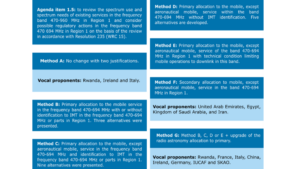

Dr Josua Pena
Space & Connectivity


In many countries in ITU Region 1, spectrum within the 470-694 MHz range is used to provide wide area coverage for broadcast television services. This spectrum also supports equipment used in the production of content and events. Over time, technological developments have improved the spectral efficiency of these services, allowing portions of historic broadcast spectrum (the 700 and 800 MHz bands) to be allocated to the mobile service. Access to these low-frequency spectrum bands has supported the cost-effective deployment of high-coverage mobile networks to help meet the increasing demand for mobile connectivity. Now, as usage of broadcast television begins to decline in some countries while the need for mobile data and connectivity remains high, WRC-23 Agenda Item 1.5 (summarised in Figure 1) seeks to balance the needs of broadcasting, mobile, and other services[1] across ITU Region 1 by reviewing the situation and considering possible regulatory action.
In the past, administrations have to some extent grouped around certain positions with respect to the broadcast-mobile spectrum debate. Countries with historically high usage of broadcast or strong public broadcasters – for example, the UK, Italy, France, and the Russian Federation – have tended to favour pro-broadcast positions. A similar trend is true for countries that have invested more recently in broadcast, such as certain countries in Africa that have completed digital switchover programmes comparatively more recently. Conversely, countries with historically low usage of broadcast, or who have invested heavily in or have widespread coverage of mobile or fixed broadband infrastructure, have tended to adopt pro-mobile positions; for instance, some Nordic, Eastern European, and Gulf countries. Similar groupings could result at WRC-23, but the complexity of the issue and the range of services affected may mean that national priorities differ.
Proponents of a mobile allocation (represented by CPM23-2 Report Methods B, C, D, E, and F) argue that such an outcome would provide regulatory flexibility for countries to decide how best to use this valuable spectrum. The improved mobile network deployment that additional low-frequency spectrum allows could help to improve connectivity. Proponents of a no-change outcome (Method A), a lower category allocation (Method F), or a delayed allocation to the mobile service (Method D4) argue that broadcast still requires access to the band in many countries (with approximately 90% of responding Region 1 administrations requiring at least the current amount of spectrum for broadcast).[2] They maintain that broadcast remains a spectrally efficient way to deliver high-quality and uninterrupted content to many viewers, not least vulnerable or disadvantaged viewers for whom an alternative may not be available or suitable.
The methods mentioned above had the support of different administrations and stakeholders during CPM23-2. In particular, the methods that had vocal defenders were method A, supported by IUCAF, Ireland, Italy, Rwanda, and China; method F, supported by the United Arab Emirates, Iran, Egypt, and the Kingdom of Saudi Arabia; and method G, supported by Ireland, Italy, France, Germany, Rwanda, China, SKAO, and IUCAF.
Regardless of the method that is chosen at WRC-23, a key desire for the outcome of Agenda Item 1.5 is regulatory flexibility. However, sharing the band between a new combination of services could be difficult. Compatibility studies have shown large variations in the separation distances required to protect users of both the broadcast and mobile services, with little consensus reached on the appropriate values. Several factors are likely to affect the difficulty associated with coordination in this band, including country size, the number of neighbouring countries, and the extent to which the spectrum usage of neighbouring countries is shielded (such as if borders are mountainous). For instance, interference management between countries with many neighbours across flat terrain or sea may be difficult. The Geneva 2006 Agreement (GE06), which governs the usage of the band and ensures the protection of coordinated usage, provides a coordination procedure. However, even with a solution allowing for regulatory flexibility resulting from WRC-23 and an agreed coordination procedure, managing the band across multiple services is likely to be difficult without regionally harmonised approaches.
This agenda item is likely to be significant at WRC-23 and may dominate a considerable amount of the discussion. Technical work has progressed but there are a number of sticking points, meaning decisions may now be based on political factors more than agreeing technical parameters.



